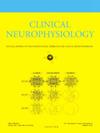听觉描述性命名背后的功能和有效连接的可视化
IF 3.7
3区 医学
Q1 CLINICAL NEUROLOGY
引用次数: 0
摘要
目的:我们可视化了特定白质网络在回答听觉描述性问题时的功能和有效连接。方法我们调查了40例日语局灶性癫痫患者,并使用皮质高伽马动态和MRI束状图估计连通性。结果在问题开始时切断一个“谁”疑问句增强了大脑半球间的功能连通性,即颞上回之间的左至右胼胝体促进流,而背外侧前额叶区域之间的右至左胼胝体抑制流则增强了功能连通性。处理与具体物体或副词相关的动词增加了左半球内的连通性,通过广泛的白质通路双向促进流动。以“是什么”开始的问题,与“在哪里”相比,在问题抵消处诱导了左侧后额叶下回更大的神经参与,与增强的功能连通性和通过弓状束向颞叶新皮层的双向促进流有关。在显性反应中,大脑半球间的功能连通性增强,罗兰区之间存在双向胼胝体流动,智商较高的个体表现出较少的左后额叶中回神经活动延长。结论在显性命名过程中,白质网络内定向神经相互作用的可视化是可行的。短语顺序可能会影响听者的网络动态,即使是在呈现传达相似含义的听觉描述性问题时也是如此。本文章由计算机程序翻译,如有差异,请以英文原文为准。
Visualization of functional and effective connectivity underlying auditory descriptive naming
Objective
We visualized functional and effective connectivity within specific white matter networks in response to auditory descriptive questions.
Methods
We investigated 40 Japanese-speaking patients with focal epilepsy and estimated connectivity measures using cortical high-gamma dynamics and MRI tractography.
Results
Hearing a wh-interrogative at question onset enhanced inter-hemispheric functional connectivity, with left-to-right callosal facilitatory flows between the superior-temporal gyri, contrasted by functional connectivity diminution with right-to-left callosal suppressive flows between dorsolateral prefrontal regions. Processing verbs associated with concrete objects or adverbs increased left intra-hemispheric connectivity, with bidirectional facilitatory flows through extensive white matter pathways. Questions beginning with what, compared to where, induced greater neural engagement in the left posterior inferior-frontal gyrus at question offset, linked to enhanced functional connectivity and bidirectional facilitatory flows to the temporal lobe neocortex via the arcuate fasciculus. During overt responses, inter-hemispheric functional connectivity was enhanced, with bidirectional callosal flows between Rolandic areas, and individuals with higher IQ scores exhibited less prolonged neural engagement in the left posterior middle frontal gyrus.
Conclusions
Visualization of directional neural interactions within white matter networks during overt naming is feasible.
Significance
Phrase order may influence network dynamics in listeners, even when presented with auditory descriptive questions conveying similar meanings.
求助全文
通过发布文献求助,成功后即可免费获取论文全文。
去求助
来源期刊

Clinical Neurophysiology
医学-临床神经学
CiteScore
8.70
自引率
6.40%
发文量
932
审稿时长
59 days
期刊介绍:
As of January 1999, The journal Electroencephalography and Clinical Neurophysiology, and its two sections Electromyography and Motor Control and Evoked Potentials have amalgamated to become this journal - Clinical Neurophysiology.
Clinical Neurophysiology is the official journal of the International Federation of Clinical Neurophysiology, the Brazilian Society of Clinical Neurophysiology, the Czech Society of Clinical Neurophysiology, the Italian Clinical Neurophysiology Society and the International Society of Intraoperative Neurophysiology.The journal is dedicated to fostering research and disseminating information on all aspects of both normal and abnormal functioning of the nervous system. The key aim of the publication is to disseminate scholarly reports on the pathophysiology underlying diseases of the central and peripheral nervous system of human patients. Clinical trials that use neurophysiological measures to document change are encouraged, as are manuscripts reporting data on integrated neuroimaging of central nervous function including, but not limited to, functional MRI, MEG, EEG, PET and other neuroimaging modalities.
 求助内容:
求助内容: 应助结果提醒方式:
应助结果提醒方式:


